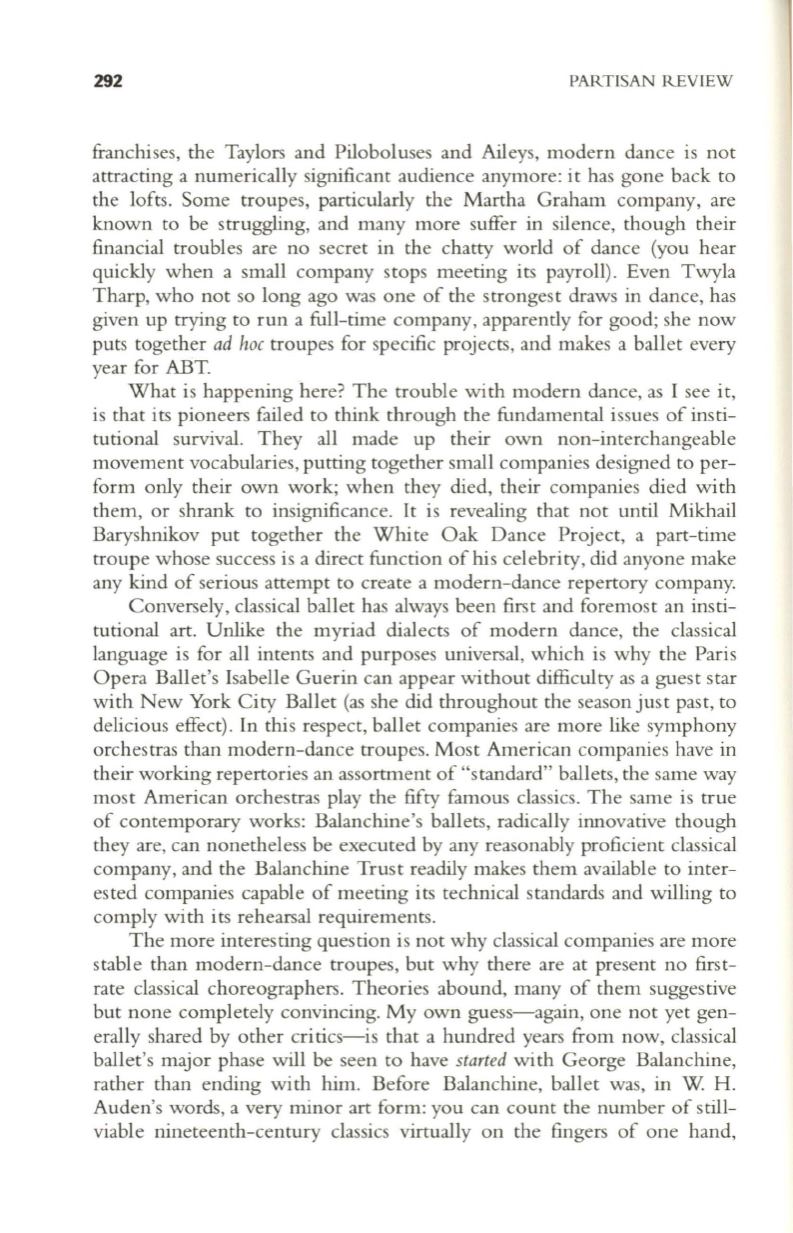
292
PARTISAN REVIEW
franchises, the Taylors and Piloboluses and Aileys, modern dance is not
attracting a numerically significant audience anymore: it has gone back to
the lofts. Some troupes, particularly the Martha Graham company, are
known to be struggling, and many more suffer in silence, though their
financial troubles are no secret in the chatty world of dance (you hear
quickly when a small company stops meeting its payroll) . Even Twyla
Tharp, who not so long ago was one of the strongest draws in dance, has
given up trying to run a full-time company, apparently for good; she now
puts together
ad hoc
troupes for specific projects, and makes a ballet every
year for ABT.
What is happening here? The trouble with modern dance, as I see it,
is that its pioneers failed to think through the fundamental issues of insti–
tutional survival. They all made up their own non-interchangeable
movement vocabularies, putting together small companies designed to per–
form only their own work; when they died, their companies died with
them, or shrank to insignificance. It is revealing that not until Mikhail
Baryshnikov put together the Whi te Oak Dance Project, a part-time
troupe whose success is a direct function of his celebrity, did anyone make
any kind of serious attempt to create a modern-dance repertory company.
Conversely, classical ballet has always been first and foremost an insti–
tutional art. Unlike the myriad dialects of modern dance, the classical
language is for all intents and purposes universal, which is why the Paris
Opera Ballet's Isabelle Guerin can appear without difficulty as a guest star
with New York City Ballet (as she did throughout the season just past, to
delicious effect). In this respect, ballet companies are more like symphony
orchestras than modern-dance troupes. Most American companies have in
their working repertories an assortment of "standard" ballets, the same way
most American orchestras play the fifty famous classics. The same is true
of contemporary works: Balanchine's ballets, radically innovative though
they are, can nonetheless be executed by any reasonably proficient classical
company, and the Balanchine Trust readily makes them available to inter–
ested companies capable of meeting its technical standards and willing to
comply with its rehearsal requirements.
The more interesting question is not why classical companies are more
stable than modern-dance troupes, but why there are at present no first–
rate classical choreographers. Theories abound, many of them suggestive
but none completely convincing. My own guess-again, one not yet gen–
erally shared by other critics-is that a hundred years from now, classical
ballet's major phase will be seen to have
started
with George Balanchine,
rather than ending with him. Before Balanchine, ballet was, in W H.
Auden's words, a very minor art form: you can count the number of still–
viable nineteenth-century classics virtually on the fingers of one hand,


